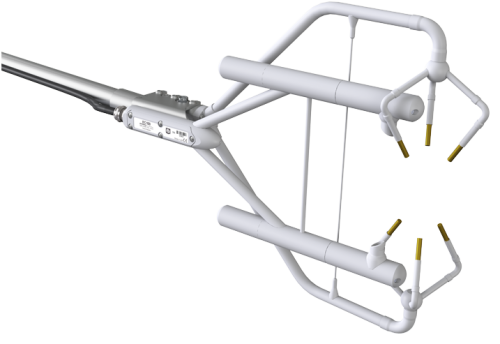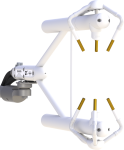
Use as part of open-path eddy-covariance systems or as a stand-alone IRGA






Overview
Campbell Scientific’s EC150 is an open-path analyser specifically designed for eddy-covariance flux measurements. As a stand-alone analyser, it simultaneously measures absolute carbon-dioxide and water-vapour densities, air temperature, and barometric pressure. With the optional CSAT3A sonic anemometer head, the EC150 also measures three-dimensional wind speed and sonic air temperature.
Read MoreBenefits and Features
- New conformal coating helps protect sonic transducers in corrosive environments
- Unique optical configuration gives a slim aerodynamic shape with minimal wind distortion
- Analyzer and sonic anemometer measurements are synchronized by a common set of electronics
- Maximum output rate of 60 Hz with 20 Hz bandwidth
- Low power consumption; suitable for solar power applications
- Low noise
- Measurements are temperature compensated without active heat control
- Angled windows to shed water and are tolerant to window contamination
- Field rugged
- Field serviceable
- Factory calibrated over wide range of CO2, H2O, pressure, and temperature in all combinations encountered in practice
- Extensive set of diagnostic parameters
- Fully compatible with Campbell Scientific dataloggers; field setup, configuration, and field zero and span can be accomplished directly from the datalogger
- Speed of sound determined from three acoustic paths; corrected for crosswind effects
- Innovative signal processing and transducer wicks considerably improve performance of the anemometer during precipitation events
Technical Description
The CSAT3A has the following outputs:
- Ux (m/s)*
- Uy (m/s)*
- Uz (m/s)*
- Sonic Temperature (°C)*
- Sonic Diagnostic*
The EC150 has the following outputs:
- CO2 Density (mg/m3)
- H2O Density (g/m3)
- Gas Analyzer Diagnostic
- Ambient Temperature (°C)
- Atmospheric Pressure (kPa)
- CO2 Signal Strength
- H2O Signal Strength
- Source Temperature (°C)
*The first five outputs require the CSAT3A Sonic Anemometer Head.
Images













Related Products
Specifications
| Operating Temperature Range | -30° to +50°C |
| Calibrated Pressure Range | 70 to 106 kPa |
| Input Voltage Range | 10 to 16 Vdc |
| Power | 5 W (steady state and power up) at 25⁰C |
| Measurement Rate | 60 Hz |
| Output Bandwidth | 5, 10, 12.5, or 20 Hz (user-programmable) |
| Output Options | SDM, RS-485, USB, analog (CO2 and H2O only) |
| Auxiliary Inputs | Air temperature and pressure |
| Gas Analyzer/Sonic Volume Separation | 5.0 cm (2.0 in.) |
| Warranty | 3 years or 17,500 hours of operation (whichever comes first) |
| Cable Length | 3 m (10 ft) from EC150 and CSAT3A to EC100 |
| Weight |
|
Gas Analyzer |
|
| Path Length |
15.37 cm (6.05 in.)
A temperature of 20°C and pressure of 101.325 kPa was used to convert mass density to concentration. |
Gas Analyzer - CO2 Performance |
|
| -NOTE- | A temperature of 20°C and pressure of 101.325 kPa was used to convert mass density to concentration. |
| Accuracy |
|
| Precision RMS (maximum) |
0.2 mg/m3 (0.15 µmol/mol)
Nominal conditions for precision verification test: 25°C, 86 kPa, 400 μmol/mol CO2, 12°C dewpoint, and 20 Hz bandwidth. |
| Calibrated Range | 0 to 1,000 μmol/mol (0 to 3,000 µmol/mole available upon request.) |
| Zero Drift with Temperature (maximum) | ±0.55 mg/m3/°C (±0.3 μmol/mol/°C) |
| Gain Drift with Temperature (maximum) | ±0.1% of reading/°C |
| Cross Sensitivity (maximum) | ±1.1 x 10-4 mol CO2 /mol H2O |
Gas Analyzer - H2O Performance |
|
| -NOTE- | A temperature of 20°C and pressure of 101.325 kPa was used to convert mass density to concentration. |
| Accuracy |
|
| Precision RMS (maximum) |
0.004 g/m3 mmol/mol (0.006 mmol/mol) Nominal conditions for precision verification test: 25°C, 86 kPa, 400 μmol/mol CO2, 12°C dewpoint, and 20 Hz bandwidth. |
| Calibrated Range | 0 to 72 mmol/mol (38°C dewpoint) |
| Zero Drift with Temperature (maximum) | ±0.037 g/m3/°C (±0.05 mmol/mol/°C) |
| Gain Drift with Temperature (maximum) | ±0.3% of reading/°C |
| Cross Sensitivity (maximum) | ±0.1 mol H2O/mol CO2 |
Sonic Anemometer - Accuracy |
|
| Offset Error |
|
| Gain Error |
|
| Measurement Precision RMS |
|
| Speed of Sound | Determined from 3 acoustic paths (corrected for crosswind effects) |
| Rain | Innovative ultrasonic signal processing and user-installable wicks considerably improve the performance of the anemometer under all rain events. |
Ambient Temperature |
|
| Manufacturer | BetaTherm 100K6A1IA |
| Total Accuracy | ±0.15°C (-30°C to +50°C) |
| EC100 ingress protection | IP65 |
Resources and Links
Manuals
Videos & Tutorials
Downloads
EasyFlux DL for CR6OP v.2.02 (99.2 KB) 31-10-2025
CR6 datalogger program for Campbell open-path eddy-covariance systems.
ECMon v.1.6 (10.7 MB) 29-03-2016
EC100-Series Support Software.
EC100 OS v.8.02 (560 KB) 14-10-2019
EC100 Operating System.
Watch the Video Tutorial: Updating the EC100 Operating System.
Device Configuration Utility v.2.33 (49.6 MB) 07-07-2025
A software utility used to download operating systems and set up Campbell Scientific hardware. Also will update PakBus Graph and the Network Planner if they have been installed previously by another Campbell Scientific software package.
Supported Operating Systems:
Windows 11 or 10 (Both 32 and 64 bit)
CSAT3H Heater Controller v.14.2 (46 KB) 02-02-2021
The CSAT3H Heater Controller ships with this encrypted program. This program is for the unlikely event that the program needs to be re-installed or updated to a newer version. Please contact Campbell Scientific if you have questions about the program or would like the algorithm modified for a specific application.
CSAT3H Heater Controller v.14.2 (46 KB) 02-02-2021
The CSAT3H Heater Controller ships with this encrypted program. This program is for the unlikely event that the program needs to be re-installed or updated to a newer version. Please contact Campbell Scientific if you have questions about the program or would like the algorithm modified for a specific application.
EasyFlux DL for CR1000XOP v.2.02 (99.2 KB) 31-10-2025
CR1000X datalogger program for Campbell open-path eddy-covariance systems.
FAQs for
Number of FAQs related to EC150: 21
Expand AllCollapse All
-
The factory calibration accounts for CO2 and H2O signal strengths down to 0.7. Therefore, to ensure quality data, windows should be cleaned before signal strengths drop below 0.7.
-
Yes. A fine-wire thermocouple, such as a FW05, can be used.
-
Factory recalibration is done on an as-needed basis. When diagnostic flags begin to appear and persist even after cleaning the analyzer and verifying its settings, a recalibration is needed. Additionally, if the performance of the analyzer has degraded, a recalibration is recommended.
One performance test is to check the absolute signal strength drift over the course of 1 year. Drift of a few percent per year is normal. If the annual signal strength drift is excessive, or if the signal strength is below 0.7 when the windows are clean, a factory recalibration is needed. Furthermore, if the ratio of the CO2 to H2O signal strength is not close to one, it may also be time for a factory recalibration.
-
The barometer and temperature sensor are needed because the IRGASON® and EC150 have been calibrated at the factory over a range of temperatures (-30° to +50°C) and barometric pressures (70 to 106 kPa).
-
The EC150 and IRGASON® gas analyzer windows are polished, slanted at an angle, and coated with a hydrophobic material to prevent water from collecting on their surfaces. Wicks may also be used on the windows to promote capillary action and move water away from the window edges. Also, heaters in the snouts may be turned on to help minimize data loss because of precipitation and condensation events.
-
The minimum height for the IRGASON® or EC150 should be approximately 2 m. Sensor placement below that height may result in a significant loss in frequency response. The maximum height depends on the available upwind fetch or footprint area. As a general guideline for unstable boundary layer conditions, the height of the sensor should be less than the distance from the sensor to the outermost edge of the footprint area divided by one hundred. For example, if there is 500 m of available upwind fetch, the IRGASON® or EC150 should not exceed a height of 5 m. Note that for neutral and stable conditions, the footprint area will grow.
-
Selecting which barometer to use is the choice of the user. There is a direct correlation between the accuracy level of the barometer and its cost.
- The basic barometer has an accuracy of ±1.5 kPa between 0° and 50°C. Below 0°, the error increases linearly to ±3.7 kPa at -30°C.
- The enhanced barometer offers an accuracy of ±0.15 kPa (-30° to +50°C).
When choosing a barometer, consider the effect of pressure accuracy on flux calculations. For sensible heat flux, the barometric pressure is used to calculate the density of air, which directly scales the sensible heat flux. Therefore, if the barometric pressure measurement is off by 1%, then the sensible heat flux will be off by 1%.
For CO2 flux, the EC150 and IRGASON® report CO2 as density. Thus, the barometric pressure is not used to directly calculate the flux. However, error in pressure measurements could cause an error in CO2 flux resulting from a CO2 span. During the span procedure, the user enters the “true CO2 value” as a CO2 concentration, which is later converted to density using the barometric pressure. Consequently, the error in CO2 measurements is directly proportional to the error in the barometric pressure measurement.
-
The power requirement for the IRGASON® or EC150 with CSAT3A is 5 W at room temperature regardless of whether it is powering up or under steady-state operation. At extreme cold or hot temperatures, the power requirement reaches 6 W.
-
For greatest accuracy, Campbell Scientific recommends that a zero and a span be done on the EC150 or IRGASON®. However, if a span gas is difficult to obtain, at the minimum, perform a zero on the analyzer. Performing a zero will correct the majority of drift experienced by the analyzer. Follow the zero procedure in the analyzer’s manual for details.
-
The frequency at which a zero/span should be done is highly dependent on site conditions; however, a monthly zero/span is a good starting point. As a general guideline, monitor the optical drift of the instrument over time to determine how often a zero/span procedure needs to be performed.
Articles and Press Releases
Newsletter Articles
Privacy Policy Update
We've updated our privacy policy. Learn More
Cookie Consent
Update your cookie preferences. Update Cookie Preferences






